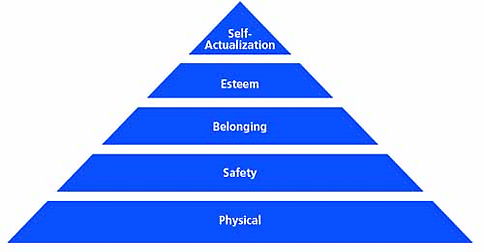ETRs and the Customer Hierarchy of Needs
 You’ve heard of Maslow’s Hierarchy of Needs theory, right? You know, the theory that utilizes a pyramid structure to show the progression of human needs (physiological, safety, love/belonging, esteem and self-actualization)? As you’ll recall, the foundational level of the pyramid represents the most basic of human needs; physiological needs like the need to breathe, eat, hydrate, and sleep.
You’ve heard of Maslow’s Hierarchy of Needs theory, right? You know, the theory that utilizes a pyramid structure to show the progression of human needs (physiological, safety, love/belonging, esteem and self-actualization)? As you’ll recall, the foundational level of the pyramid represents the most basic of human needs; physiological needs like the need to breathe, eat, hydrate, and sleep.
If we were to update the pyramid for the utility industry, “keeping the lights on” or “keeping the gas flowing” would certainly be included as one of the most basic, fundamental human needs (yes, I can imagine Abraham Maslow rolling over in his grave right about now!). Customers want reliability more than anything from their utilities.
Following Maslow’s model, it is reasonable to assume that meeting the most basic of customer needs requires that municipal and public utilities strive to continuously figure out ways to accelerate their restoration processes, and to improve the calculation and communication of ETRs (estimated times of restoration, also sometimes referred to as ERTs – estimated restoration times). Simply put, customers want the root cause of outages assessed quickly, and ETRs communicated accurately. And when it comes to ETRs, there are 4 crucial best practices for maximum customer satisfaction…
Best Practice #1: Don’t Leave Them Hanging
Accurate and timely communication is not just a best practice for utility ETRs…it is THE best practice. Why so important? Because I don’t care how good the ETR calculations are, if they are not effectively communicated, your customers will not be satisfied. Luckily, it’s a lot easier to communicate these days than it was even a decade ago.
Today, the proliferation of social media and smart mobile devices dramatically simplifies the task. Facebook, Twitter, and even Google+ can be used to broadcast ETR updates, which customers can then access at any time via their laptop, smart phone, or any other web-enabled device. Of course, customers must be educated on which social media channels to tap into for this information, but this can be done in a number of ways. Some examples include:
- Statement messages
- Bill stuffers
- The company website
- Interactive voice response (IVR)
- Blast emails
- Radio advertising
Best Practice #2: Don’t View ETRs in a Vacuum
The establishment of benchmarks – performance metrics as well as customer satisfaction metrics – is also fundamental to any discussion about ETR best practices. Benchmarking can be done based on industry or regional averages, company performance at specific points in time, or (ideally) both. Some states, including New York, have established a scorecard for use in holding utilities accountable to certain performance levels during major storms.
Once benchmarks are established, measuring your company’s performance against them over time will help identify performance gaps and measure overall progress toward process improvement.
Best Practice #3: Look Backward to Move Forward
Another important aspect of ETR development is a commitment to conducting post-outage lessons learned sessions. Analyzing and evaluating what went right and what went wrong in terms of ETR development and communication will help improve the efficiency and effectiveness of the process going forward. Utilities that are unable or unwilling to harness lessons-learned to improve ETR processes will fall behind those that do.
Best Practice #4: Keep Your Restoration Plan Updated
Emergency restoration plans should be reviewed and updated regularly, incorporating new findings from benchmarking analyses, customer surveys, and post-outage lessons learned sessions. For example, you may find that customers prefer Facebook over Twitter for ETR information, or that specific damage assessment tactics can be leveraged to improve the accuracy of ETR calculations. The bottom line is that any learning, no matter how seemingly inconsequential, must be used to update the plan at least annually.
Conclusion
Unlike just a decade ago, today’s populace is characterized by 24/7 connectivity, which means that utility customers are no longer willing to proverbially “wait in the dark” for their electricity to return. Now within minutes they are reaching for their cell phones and other connected devices to call their utilities, check their outage notification web pages, tweet, or post a Facebook status to announce their lack of electricity.
Quickly responding to an outage and restoring power is a critical element of customer satisfaction. Equally important, however, is maximizing the accuracy and communication reach of ETRs so customers can access the information they need quickly. In the final analysis, there’s little doubt; prompt, specific, timely and accurate ETR information means the difference between a responsive, engaged customer and an angry, dissatisfied one.

